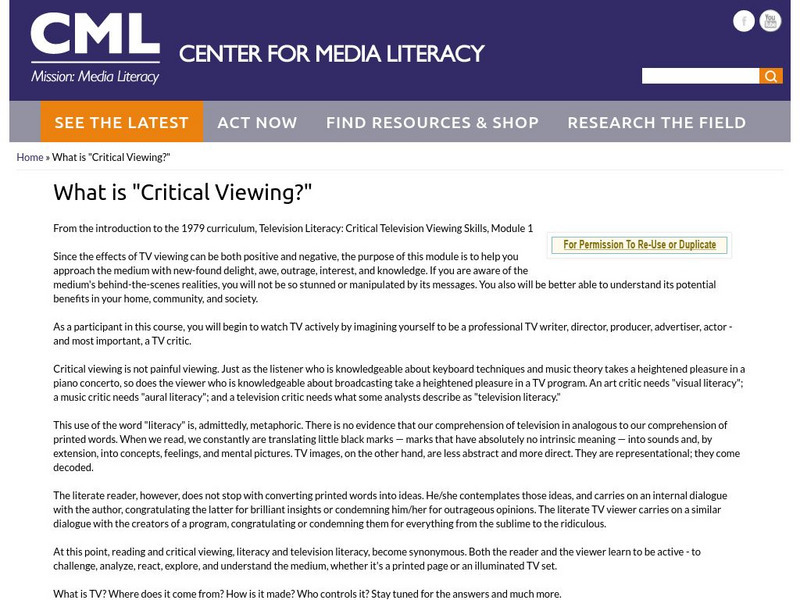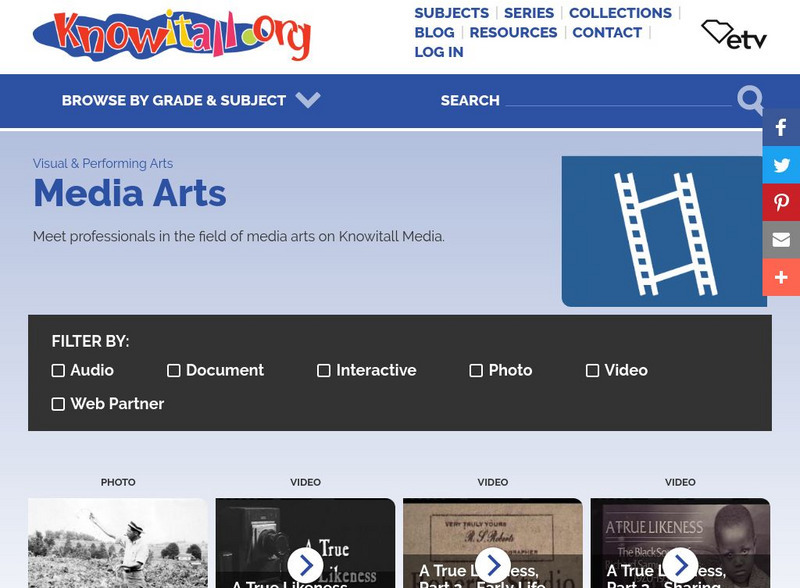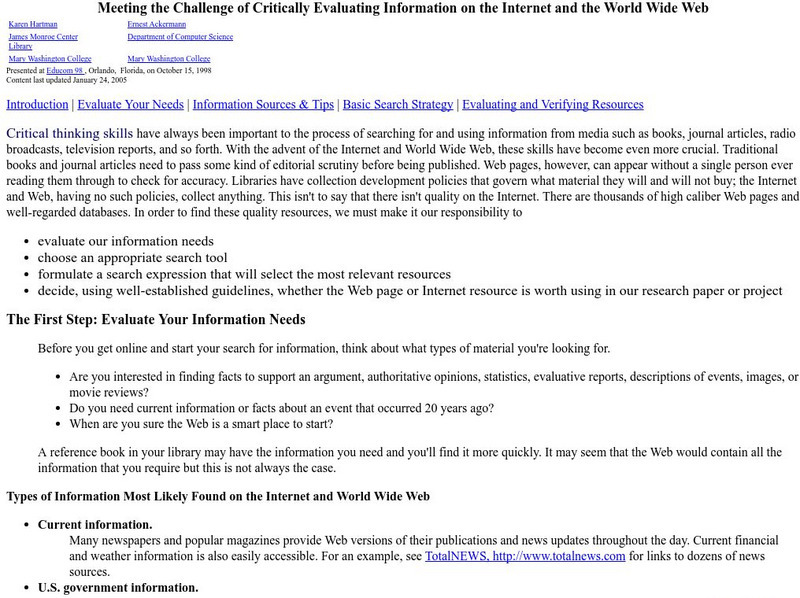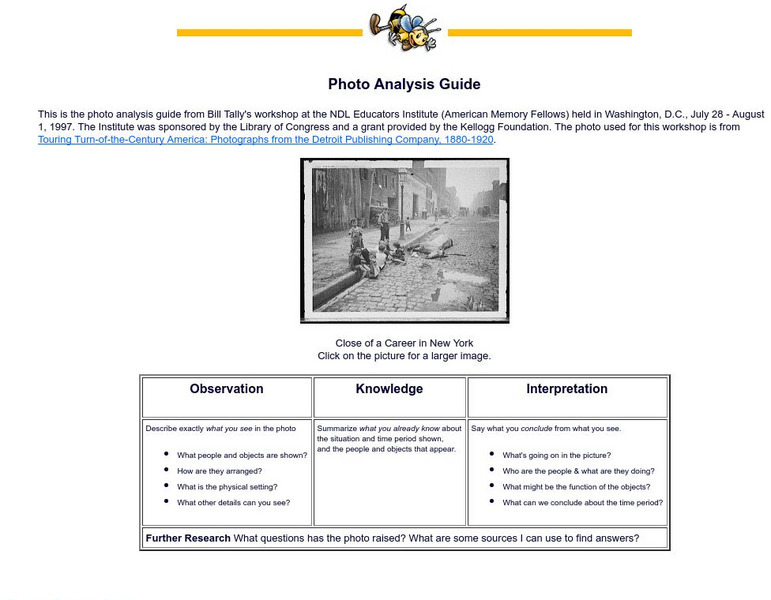Other
Center for Media Literacy: What Is "Critical" Viewing?
Understand the term "critical viewing" as it relates to visual literacy. Learn how to assess the media around you in order to become more knowledgeable and not easily manipulated by what you see.
Other
Center for Media Literacy: What Is "Critical" Viewing?
Understand the term "critical viewing" as it relates to visual literacy. Learn how to assess the media around you in order to become more knowledgeable and not easily manipulated by what you see.
PBS
Pbs Learning Media: Alma's Way: Think It Through
As Alma learns about families, friendships, and communities, she discovers that sometimes challenges and conflicts arise. In those moments, Alma stops and "thinks through" the situation. Then, she knows what to do! Support critical...
South Carolina Educational Television
Etv: Visual and Performing Arts: Sculpture
Take a one-minute tour through the history of sculpture. View a variety of sculpture techniques and be a sculpture critic. Visit the sculpture studio and learn about carving, casting and modeling. Meet artists, and see them at work....
South Carolina Educational Television
Etv: Visual and Performing Arts: Media Arts
Take a one-minute tour through the history of media arts. Examine a variety of media forms and be a media critic. Visit the Media Studio and learn about movie soundtracks, animation, and creating a storyboard. Meet different artists as...
Sophia Learning
Sophia: 5 Core Concepts of Media Literacy
In this lesson, students will engage in multiple parts of a lesson that guide students to uncover many levels of meaning in media messages. Discussion questions and a slideshow presentation are parts of the lesson that address the...
Other
Webliminal: Critically Evaluating Information on the Internet
This site gives excellent information on why it's important to evaluate the content of everything you find in cyberspace, and also tells you how to do so. It also contains information about using search engines effectively and how to...
Other
Western Illinois University: Thinking Visually and Evaluating Visuals
This site explores: "An Attitude/Preparing a Frame of Mind," "Thinking Visually: Being First, Doing Second," and "Evaluating Visuals." Click on each to get detailed information. CCSS.ELA-Literacy.CCRA.R.7
Other
Academia.edu: Teaching Media Savvy Students About the Popular Media
In order to teach critical viewing skills, it is essential that educators understand what their students already know and understand about popular media. CCSS.ELA-Literacy.CCRA.SL.2
Other
Media Education Foundation: Deconstructing an Advertisement [Pdf]
Outline of the steps involved and the questions to ask in critically assessing a print advertisement.
Books in the Classroom
Carol Hurst's Children's Literature Site: Looking Critically at Picture Books
This site describes several ideas and activities to use with picture books and intermediate/middle school age students. Specific title to use are also given.
Other
Partnership for 21st Century Skills: Skills Map for the Arts [Pdf]
Arts education is part of the backbone of the 21st Century skills movement. The Partnership for 21st Century Skills had designed a map that provides examples of collaboration, communication, creativity, innovation, critical thinking,...
Other
Partnership for 21st Century Skills: Skills Map for the Arts [Pdf]
Arts education is part of the backbone of the 21st Century skills movement. The Partnership for 21st Century Skills had designed a map that provides examples of collaboration, communication, creativity, innovation, critical thinking,...
ClassFlow
Class Flow: Southwest Literacy Unit
[Free Registration/Login Required] This flipchart is a literacy unit based around a Southwest / Westward Expansion Theme. Native Americans, pioneers, and the old west is covered. 8 different literacy strategies are taught with FULL...
Cyberbee
Cyberbee: Photo Analysis Guide
This site is a guide to help students analyze visual media. Further research questions included.
ReadWriteThink
Read Write Think: Buddies Create Power Point Stories
Contains plans for five lessons that ask students to create PowerPoint presentations about shared experiences like field trips or other activities. Students take pictures of what happen, and then explain the sequence of events in words...
ReadWriteThink
Read Write Think: Cover to Cover: Comparing Books to Movies
A 7-lesson unit where students critically analyze how a film adaptation portrays a novel to see what impact it had on the retell of the story. They then design a movie DVD cover and write a DVD insert based on what they have learned. The...
ArtsNow
Arts Now Learning: Mona Mesa: What Is Your Opinion? [Pdf]
In this lesson, 1st graders look at a print of "Mona Lisa" by Leonardo DaVinci and talk about what they see, searching for visual clues to help them form an opinion. They discuss the importance of portrait paintings during the...
Annenberg Foundation
Annenberg Learner: Artifacts and Fiction: Workshop in American Literature
This workshop, which is divided into eight segments, teaches how to use primary source artifacts from a variety of genres to support the teaching and learning of specific pieces of literature. The genres include visual arts, political...
Annenberg Foundation
Annenberg Learner: American Passages: A Literary Survey: Archive
This search engine provides access to more than 3000 items including visual art, audio files, primary source materials, and additional texts supporting and enriching the understanding of American Literature. RI.9-10.9 US Documents,...
Library of Congress
Loc: Photo Analysis Presenting the Statue of Liberty
The ability to examine a primary source is a gateway to building critical thinking skills and constructing knowledge. This lesson provides the students an opportunity to observe similarities and differences between 2 visual images,...
Other
Dade Schools: John Ferguson: Informational Text Features
A table explaining different text features including graphics, visuals, and sections found in text.
ArtsNow
Arts Now Learning: Self Portrait Collage [Pdf]
In this instructional activity, young scholars look at how non-human images can be used in a self-portrait to portray aspects of a personality.














